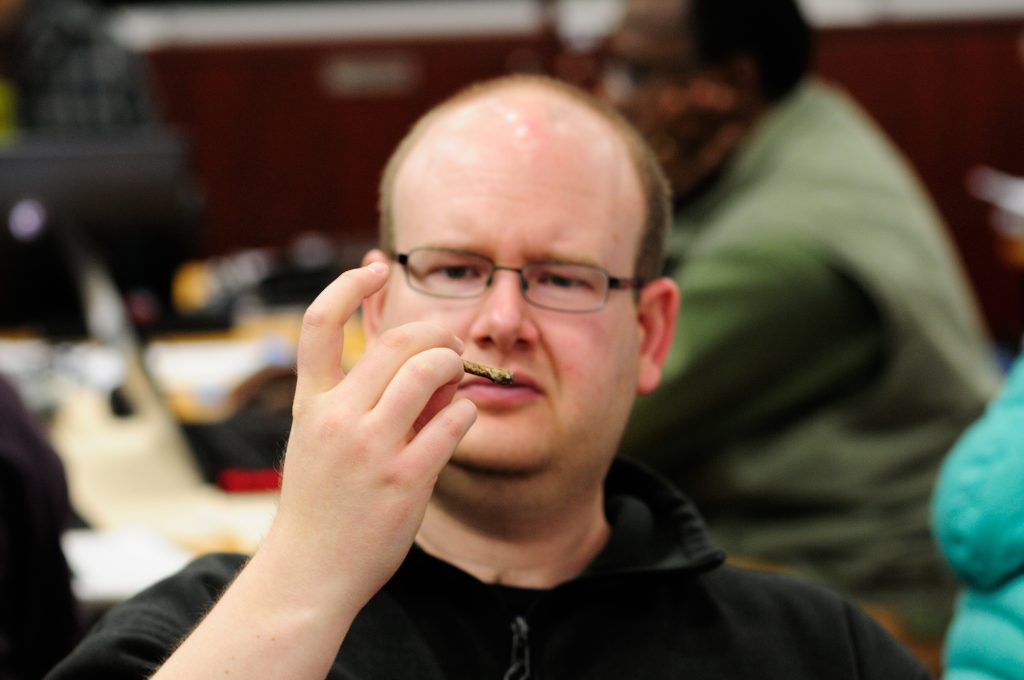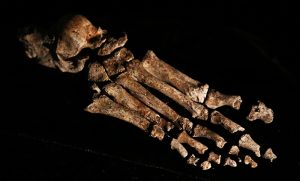UIndy alum assists in science breakthrough
 Dr. Zachary Throckmorton, who earned a UIndy master’s degree in 2007, examines a fossil specimen at the Evolutionary Studies Institute of South Africa’s University of the Witwatersrand. (photo by William Harcourt-Smith)
Dr. Zachary Throckmorton, who earned a UIndy master’s degree in 2007, examines a fossil specimen at the Evolutionary Studies Institute of South Africa’s University of the Witwatersrand. (photo by William Harcourt-Smith)
Previously unknown species sheds new light on human evolution
The worlds of science and pop culture alike were rocked last week by a landmark announcement, and a University of Indianapolis alumnus had a hand in it – or, perhaps more accurately, a foot.
Dr. Zachary Throckmorton ’07, now a professor at Tennessee’s Lincoln Memorial University, is among a select international group of scientists who were invited to study specimens and co-author the first published analyses of a previously unknown species of ancient hominin. In a barely accessible cave chamber in South Africa, Homo naledi appears to have deliberately interred the bodies of its dead, a practice once thought exclusive to modern humans.
The news was announced Thursday through two papers in the scientific journal eLife and a story on the National Geographic website, followed by media accounts worldwide. The project is the cover story in National Geographic’s October issue and the subject of a NOVA/National Geographic Special that is viewable online and airs for the first time Wednesday night. Even The Onion offered a typically cheeky take on the news.
Throckmorton, 34, who came to UIndy in 2004 to study evolutionary anatomy under Professor John Langdon and earn his Master of Science in Human Biology, said by phone this week that the ongoing project is the opportunity of a lifetime.
“Every once in a while there’s a remarkable discovery or development in the field that provides an enormous amount of new data that is really exciting for everyone in the field to start considering,” the Michigan native said. “If you had told me in 2004, ‘Hey, you’d better get back to studying because in a decade you’re going to have an opportunity to describe a new species of the genus Homo,’ I would have said ‘Yeah, sure.’”
In addition to his former adviser Langdon (“It’s kind of cool to be able to call him ‘John’ now”), Throckmorton has stayed in touch with many of the UIndy faculty members he studied under or met while rising through the academic ranks: Stephen Nawrocki, Christopher Schmidt, Sandra Davis, Roger Sweets and Krista Latham, as well as the retired Mary Ritke and Gerald Zimmerman, among others.
“My gratitude is to the Anthropology and the Biology departments there,” he said. “They were all very kind to a young graduate student when I showed up there, and I learned a lot from them.”
The Homo naledi fossils were first uncovered in 2013 in a cave known as Rising Star near Johannesburg, South Africa, on expeditions led by Lee Berger, a research professor at the nearby University of the Witwatersrand. Throckmorton, who earned his master’s and doctoral degrees in anthropology from University of Wisconsin-Madison, got involved by responding to a callout issued through social media and the National Geographic website, which specifically sought up-and-coming young scientists with particular specialties to join in the analysis of the specimens.

With his expertise in the evolution of the human foot and ankle, Throckmorton was among the lucky few selected from hundreds of applicants. He spent six weeks during the summer of 2014 and another three weeks this spring participating in the Rising Star Workshop at University of the Witwatersrand’s Evolutionary Studies Institute, helping to describe what had been found.
Initially, the guest researchers knew something special was happening but had no idea how groundbreaking the new discovery was.
“I figured that they had found maybe two or three reasonably well-preserved skeletons from an already existing and already known species of hominin,” he recalls. “It was very quickly apparent that we had over 1,500 different identifiable bones and that this was a fossil assemblage that was completely unprecedented in the African hominin fossil record. And it became fairly clear about a month into the workshop that we were dealing with a previously undescribed species whose anatomy was sufficiently different from the anatomy of other known species of extinct humans that it warranted getting its own species.”
The anatomy of Homo naledi resembles modern humans in many ways, Throckmorton says, even though its brain was only a third of the size. Various factors have complicated efforts to date the specimens, but so far that has helped the researchers avoid preconceived notions that might bias their observations.
“The part that I work on, the foot and ankle, is very modern,” he says. “Whereas, say, the shoulder joint is not modern-like at all, and anyone can see the differences.”
On the heels of the initial announcement, Throckmorton elaborates further on his findings in another paper set to be published this month in another major scientific journal. And all of this groundbreaking news is “really just the tip of the iceberg” in terms of what scientists eventually can learn from Homo naledi and from other fossil evidence that is almost sure to be found in Rising Star Cave.
Throckmorton looks forward to the challenge, and he points again to UIndy as a crucial step in his own evolution as a scientist.
“I am very fortunate,” he says. “And I would not be here and I would not have had this opportunity if it weren’t for Dr. Langdon. … He busted my chops when I thought I could get away with being a bum. He knew what I was capable of, and he pushed me to do what I could, and that’s what I needed when I was 23.”
